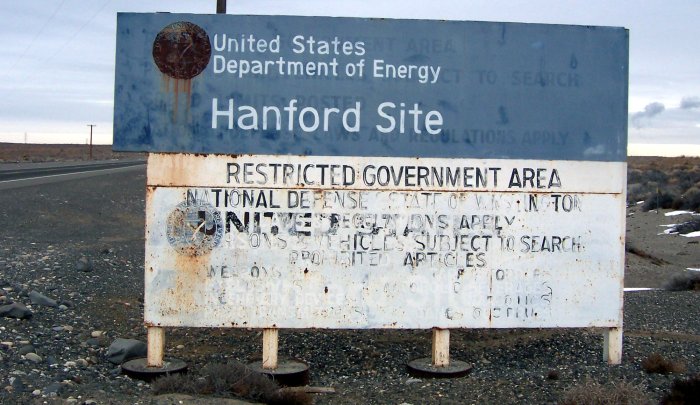Groups demand DOE end plans to send waste to Hanford
Article by Annette Cary, Herald staff writer
A coalition of Northwest environmental groups is demanding that Energy Secretary Steven Chu end any plans to import radioactive waste to Hanford.
The Department of Energy agreed as part of a proposed settlement with the state of Washington not to send most types of radioactive waste to Hanford for disposal until the vitrification plant is in full operation to treat the worst waste now stored in underground tanks. That's scheduled for 2022.
The coalition is asking Chu to issue a formal decision that DOE not add more waste to Hanford and conduct a new environmental study if DOE revisits the issue after 2022.
"Citizens of the Pacific Northwest will not tolerate off-site waste exacerbating Hanford's existing threats to the Columbia River and people of the Northwest," said the letter signed by leaders of Columbia Riverkeeper and Heart of America Northwest. It also listed 19 other organizations.
A new 6,000-page draft environmental study -- the Hanford Tank Closure and Waste Management Environmental Impact Statement -- shows that importing radioactive waste for disposal at Hanford would significantly increase pollution in ground water beneath the nuclear reservation.
Under some scenarios that appear likely, the amount of certain long-lived radioactive isotopes that would be imported and buried at Hanford would account for as much as 90 percent of the releases of that isotope to the environment, according to the state. Some of the worst contamination could occur 1,000 or more years from now.
The draft study prepared by DOE looks at sending 107,000 cubic yards of radioactive waste, some mixed with hazardous chemicals, to Hanford for disposal. That waste would be covered by the moratorium until about 2022.
The environmental groups want a revised draft of the study to be released that does not propose adding off-site waste to Hanford low-level and low-activity radioactive waste to be buried at Hanford landfills.
The waste at Hanford now is left from the past production there of plutonium for the nation's nuclear weapons program.
DOE agreed in the study that importing waste to Hanford with specific amounts of certain radioactive isotopes, particularly iodine 129 and technetium 99, could have an adverse impact on the environment.
It suggested two alternatives: Robust treatment of imported waste such as turning it into glass before burying it at Hanford or restricting disposal of waste with those isotopes.
Additional groups signing onto the letter are the Sierra Club Cascade Chapter, the Oregon Sierra Club, Spokane Riverkeeper, Washington Chapter of Republicans for Environmental Protection, Northwest Environmental Defense Center, Friends of the Columbia Gorge, The Lands Council, Center for Environmental Law & Policy, Oregon Toxics Alliance, Rosemere Neighborhood Association, Eastern Washington Voters, Hanford Challenge, Portland Chapter of the Alliance for Democracy, Hanford Watch, Hells Canyon Preservation Council, Washington Physicians for Social Responsibility, Oregon Physicians for Social Responsibility, Olympic Environmental Council and Silver Valley Community Resource Center.
The Department of Energy agreed as part of a proposed settlement with the state of Washington not to send most types of radioactive waste to Hanford for disposal until the vitrification plant is in full operation to treat the worst waste now stored in underground tanks. That's scheduled for 2022.
The coalition is asking Chu to issue a formal decision that DOE not add more waste to Hanford and conduct a new environmental study if DOE revisits the issue after 2022.
"Citizens of the Pacific Northwest will not tolerate off-site waste exacerbating Hanford's existing threats to the Columbia River and people of the Northwest," said the letter signed by leaders of Columbia Riverkeeper and Heart of America Northwest. It also listed 19 other organizations.
A new 6,000-page draft environmental study -- the Hanford Tank Closure and Waste Management Environmental Impact Statement -- shows that importing radioactive waste for disposal at Hanford would significantly increase pollution in ground water beneath the nuclear reservation.
Under some scenarios that appear likely, the amount of certain long-lived radioactive isotopes that would be imported and buried at Hanford would account for as much as 90 percent of the releases of that isotope to the environment, according to the state. Some of the worst contamination could occur 1,000 or more years from now.
The draft study prepared by DOE looks at sending 107,000 cubic yards of radioactive waste, some mixed with hazardous chemicals, to Hanford for disposal. That waste would be covered by the moratorium until about 2022.
The environmental groups want a revised draft of the study to be released that does not propose adding off-site waste to Hanford low-level and low-activity radioactive waste to be buried at Hanford landfills.
The waste at Hanford now is left from the past production there of plutonium for the nation's nuclear weapons program.
DOE agreed in the study that importing waste to Hanford with specific amounts of certain radioactive isotopes, particularly iodine 129 and technetium 99, could have an adverse impact on the environment.
It suggested two alternatives: Robust treatment of imported waste such as turning it into glass before burying it at Hanford or restricting disposal of waste with those isotopes.
Additional groups signing onto the letter are the Sierra Club Cascade Chapter, the Oregon Sierra Club, Spokane Riverkeeper, Washington Chapter of Republicans for Environmental Protection, Northwest Environmental Defense Center, Friends of the Columbia Gorge, The Lands Council, Center for Environmental Law & Policy, Oregon Toxics Alliance, Rosemere Neighborhood Association, Eastern Washington Voters, Hanford Challenge, Portland Chapter of the Alliance for Democracy, Hanford Watch, Hells Canyon Preservation Council, Washington Physicians for Social Responsibility, Oregon Physicians for Social Responsibility, Olympic Environmental Council and Silver Valley Community Resource Center.






